Another Code: Two Memories (Trace Memory) (Nintendo DS) Review
By Adam Riley  03.09.2005
03.09.2005
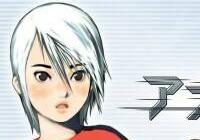
The point-and-click genre on the PC has gradually been withering away over the years as the platform has lost its selling power. But now with the advent of the Nintendo DS and its touch-screen, the possibilities for reviving this once extremely popular style of game have definitely increased considerably. Quick off the mark, Nintendo has worked closely with Japanese developer Cing to bring such a game to the new market, but does it work as well as the PC games?
Ashley Robins lost her parents at the tender age of three, when someone broke into their home and a tragic event occurred. Eleven years later, one the eve of her fourteenth birthday she receives a mysterious package, which includes an unusual machine and a note from Richard, her father. Confused, her Aunt Jessica explains that his survival had to remain a secret and that he will reveal everything once they all meet on Blood Edward Island. So begins Ashley's strange and wonderful adventure...
A lot of focus was initially placed on the visual side of the Nintendo DS's first batch of games, with Super Mario 64 DS setting the standard for being higher than the N64 and the rest of the competition basically paling in comparison. Another Code, however, is quite an oddity, with its own visual style working to its advantage. What you have is two different representations across the two screens of the DS. On the lower one there is an isometric/semi-overhead viewpoint where you control the main character by touching on where you want her to move to, then she runs there. This looks extremely tidy for the 3D characters moving around (you have a ghostly friend called 'D' by your side most of the time). Then there are the static rendered images that appear on the top screen, which look beautiful, as you would expect from that style. With gorgeous lighting and atmospheric design, the places of importance that show up once your character has moved to the correct position are a pleasure to look at. More impressive than these, though, are the hand-drawn anime cut-scenes that litter Another Code - some of the best imagery on the DS so far and again, sets the tone of the game perfectly.
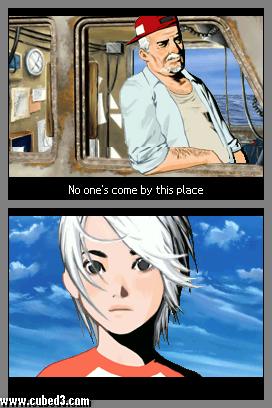
The same has to go for the aural side of the adventure, with nothing that particularly jumps out and grabs your attention, but more than enough to keep the mood spot on. Haunting pianos are usually a clever way of giving the impression of a large, but empty location and this trick is used impeccably in Another Code. However, it is not simply an eerie feeling that is brought to the gamer’s ears whilst playing, but that of strong emotion as well. During play you find out more about Ashley and the apparition that floats alongside her, and at the appropriate times the score will change to tug at those heartstrings and ensure you feel more engaged in the happenings of the journey. A notable soundtrack can make a game and Cing hit the accurate note...
Hands up Nintendo fans that are familiar with the point-and-click genre? Okay...Now hands up those who know all about the context sensitive button system that is used in the likes of Zelda? That is much better. Right, for those few that are still looking puzzled, the basic idea behind the play mechanic in those games and Another Code here on the Nintendo DS is that if you move toward something, then your controls adapt to the situation. Link can climb up objects when stood by them by just pressing the same button he was using earlier to pick something up with. In the likes of Broken Sword and Monkey Island, click the mouse pointer where you want to move to, watch as George Stobbart or Guybrush Threepwood walk over to that point and see how the cursor changes to suit the next occasion.
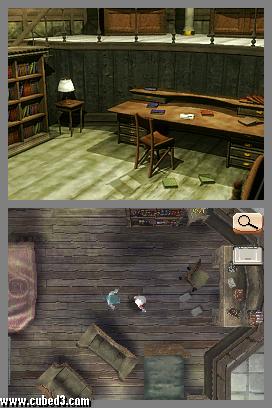
This is how Another Code works, to a degree. Tapping on the touch-screen and holding that position will make Ashley run toward that point and if you then move into a position that is of interest (according to the game), the general image on the top the screen will change and the spyglass icon will appear in the top-right of the lower screen. Pressing this zooms you into the above image and lets you move the on-screen cursor around to interact with the various objects around. For instance, either clicking on a bookcase and pressing the spyglass again, or just double-tapping the bookcase will make Ashley automatically search through it for any useful items, clues or information cards that can be used on the device her dad sent her for a birthday present (the DAS, Dual Another System, which amazingly enough looks just like a DS!).
The aim is to collect items that can then be used to unlock other pathways (a lighter to set candles alight in the right order, thus opening a secret passage) or open up puzzles for you to solve (over-laying two images and moving them around until you obtain the right code for a locked door later on). The level of creativity found in the puzzles throughout the game is truly magnificent at times. I do not want to spoil some of the more in-depth brainteasers, but let me just say that a few of the ways that the DS portable's features and layout are used left me saw awe-struck that I pray to Nintendo that a sequel is in the offing!
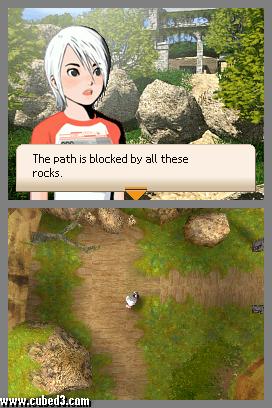
As you progress, you will uncover little secrets about the reason why your father not only deserted you for so many years, but is absent from the initial meetings place at the harbour, truths regarding Ashley's mother, information on the mysterious Edwards family (who the island is named after), as well as helping to piece together the memory of your spirit-friend 'D'. Whilst initial play-tests of this at Nintendo events did not give a positive impact, sitting a playing through Another Code in a leisurely manner, soaking in the full atmosphere of the game proves to be a spectacular experience that should not be missed by adventure fans!
Something needs to be mentioned here and that is most point-and-click adventures are rather short in nature, depending on your skill level at solving out of the ordinary puzzles and piecing information together. This game in particular, for someone who could be classed as a veteran of the genre, took almost eight hours to get through. Those who have played the excellence of the Castlevania series on the GBA will know that whilst that sounds like a short time, if the enjoyment factor is high enough then it simply does not matter. Especially if you can play through the title again with the bonus of something extra - as in Another Code as well. Therefore, do not feel like you are being short-changed. The game is so damn fun and engrossing that even if it were fifteen hours long it would fly by very quickly.
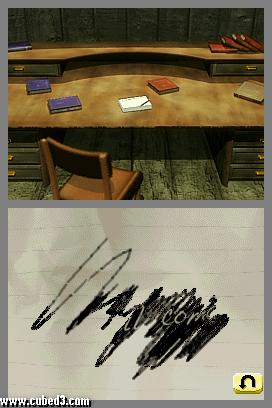
Cubed3 Rating
Exceptional - Gold Award

Another Code: Two Memories is a unique DS game that has an open market to flourish on. So far its success has been moderate in Europe and Japan, but with the US version out this month it is hoped this superb adventure game gets the attention it deserves!
Comments
Comments are currently disabled

 Sign In
Sign In Game Details
Game Details
 Out now
Out now  Out now
Out now  Out now
Out now  Out now
Out now  Subscribe to this topic
Subscribe to this topic Features
Features





 Top
Top

